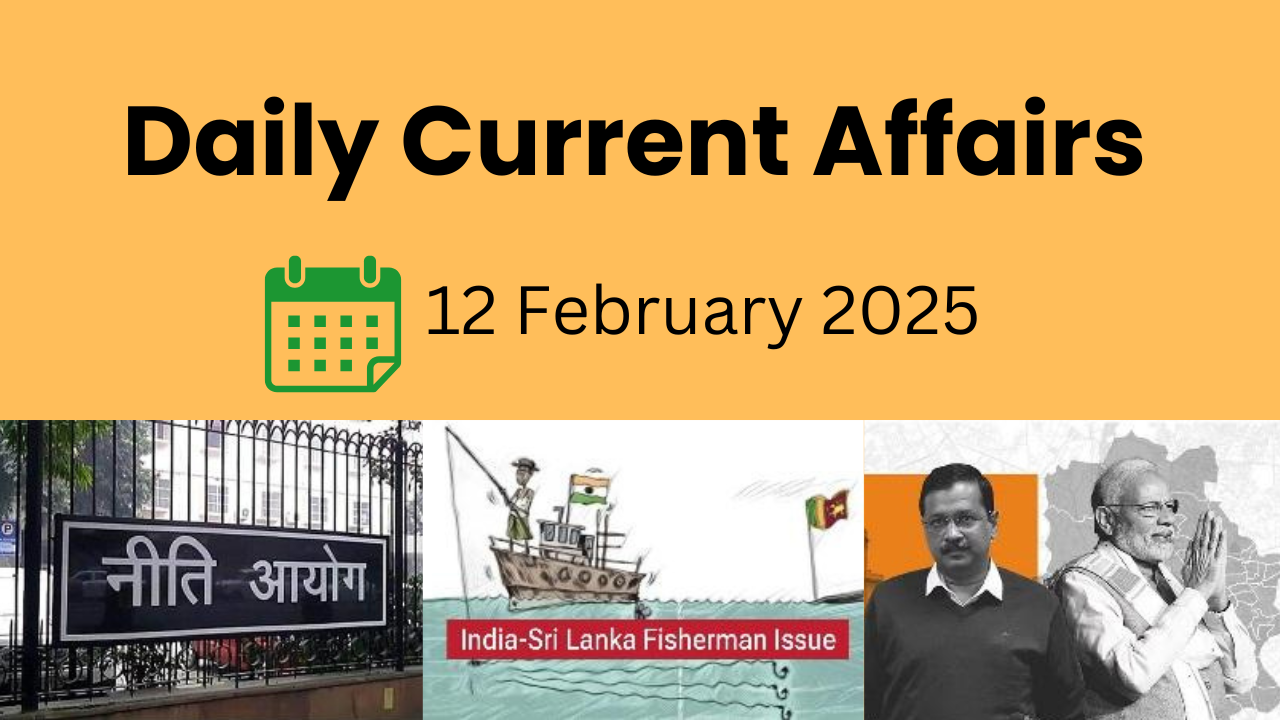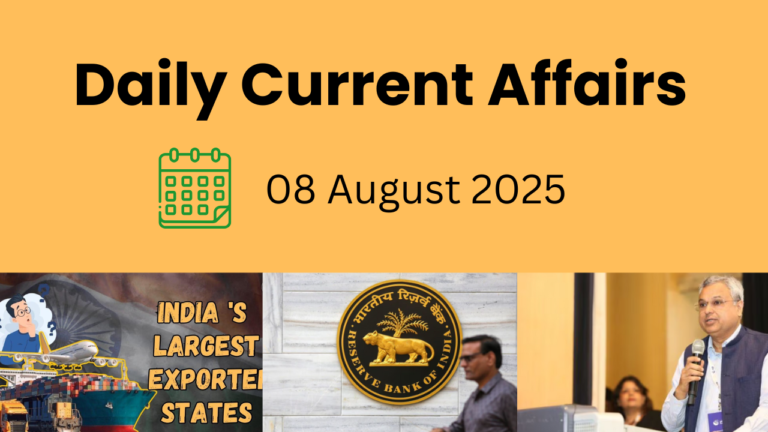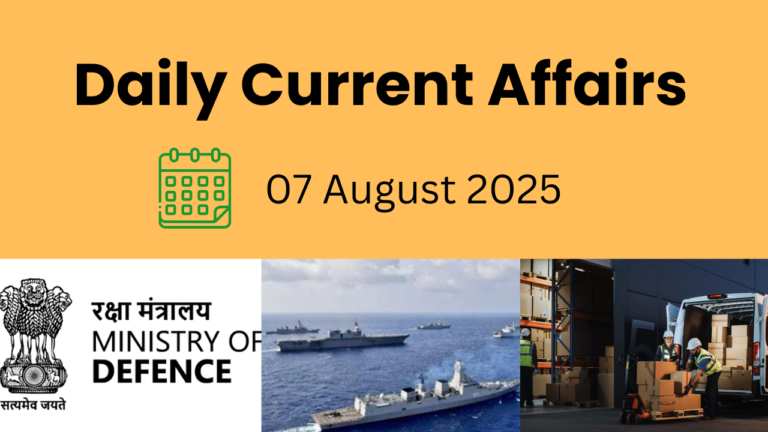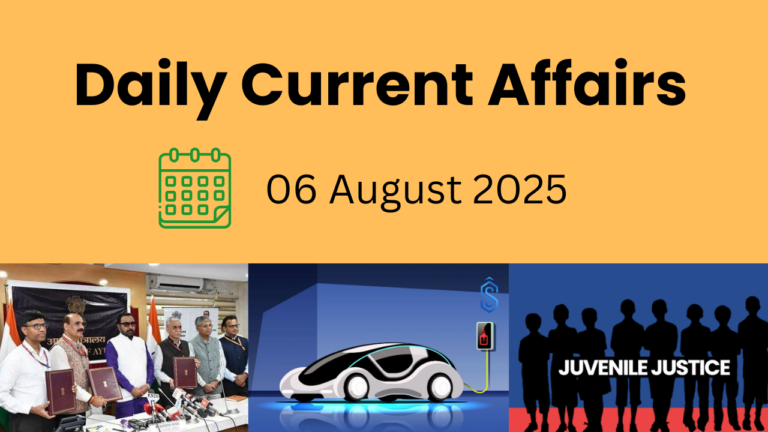1. NITI Aayog’s Policy Report on State Public Universities (SPUs)
Context: NITI Aayog has released a comprehensive policy report titled ‘Expanding Quality Higher Education through States and State Public Universities’. This first-of-its-kind document focuses on State Public Universities (SPUs), analyzing key aspects such as quality, funding, governance, and employability in higher education.
What Are State Public Universities (SPUs)?
An SPU is a university established or incorporated by a Provincial Act or a State Act. These institutions play a crucial role in expanding access to higher education across India.
Key Findings:
1. Higher Education Funding:
- Highest Funding: Maharashtra leads in higher education funding, followed by Bihar and Tamil Nadu.
- Lowest Funding: Sikkim, Arunachal Pradesh, and Nagaland have the lowest higher education budgets.
2. University Density:
- The national average university density is 0.8.
- Sikkim has the highest density at 10.3, followed by Arunachal Pradesh, Ladakh, Himachal Pradesh, Meghalaya, and Uttarakhand.
- Bihar, Uttar Pradesh, West Bengal, and Maharashtra have a university density below the national average.
3. Female Enrolment:
- Kerala, Chhattisgarh, and Himachal Pradesh have higher female enrolment rates than males.
Challenges in SPUs
- Infrastructure Deficiencies: Lack of modern and high-quality infrastructure.
- Faculty Shortage: Insufficient teaching and administrative staff.
- Limited R&D Expenditure: Low investment in research and innovation.
- Low Enrolment in MTech & Ph.D.: Hindering advanced research and academic progress.
- Outdated Curriculum: Courses and syllabi are not aligned with industry needs.
- Funding Issues:
- Heavy reliance on state grants and admission fees.
- Delays in fund sanctioning due to administrative bottlenecks.
- Absence of a structured bank loan framework for SPUs.
Key Recommendations:
1. Increased Investment in Education & R&D:
- Total education investment (Centre + States) should be raised to 6% of GDP as per NEP 2020.
- R&D investment (public + private) should be 2% of GDP as per the Economic Survey 2017-18.
2. Establishing Centres of Excellence:
- SPU clusters should identify 2-3 local issues and establish dedicated research centres to solve them.
3. Specialized Financing Agency for SPUs:
- States should create a Higher Education Financing Agency (HEFA)-like body specifically for SPUs.
- HEFA, a joint venture of the Centre and Canara Bank, was set up in 2017 to strengthen infrastructure and research in higher education institutions.
Conclusion:
The report provides nearly 80 policy recommendations to strengthen the quality, governance, and financial sustainability of SPUs. By implementing these suggestions, India can enhance the higher education sector and foster greater academic excellence.
2. Centre vs Delhi Government: Constitutional Conflict and Supreme Court Rulings
Context: The governance of Delhi, India’s national capital, has been a contentious issue for years, fueling ongoing legal disputes between the AAP-led Delhi Government and the BJP-led Central Government. The central issue revolves around Delhi’s unique constitutional status, which designates it as a Union Territory (UT) with a legislature.This setup has led to significant struggles over administrative control, particularly concerning bureaucratic appointments, law enforcement, and governance powers. These conflicts have prompted multiple Supreme Court (SC) interventions and amendments to the existing governance laws.
Constitutional Status of Delhi:
Delhi’s governance is defined by Article 239AA of the Indian Constitution, introduced through the Sixty-Ninth Constitutional Amendment Act (1991). This article grants Delhi:
- A Legislative Assembly with powers to legislate on subjects from the State List and Concurrent List, except on matters like police, public order, and land.
- An elected Chief Minister (CM) and a Council of Ministers responsible for day-to-day administration.
- A Lieutenant Governor (L-G), appointed by the President of India, who represents the Centre in Delhi.
This division of powers has frequently led to jurisdictional conflicts, policy clashes, and administrative control disputes.
Legal Battles Between Centre and Delhi Government:
The 2015 Notification and Initial Conflict:
When AAP returned to power in Delhi in 2015, the Union Home Ministry issued a notification giving the L-G control over bureaucratic services, land, police, and public order. The Delhi Government challenged this decision in the High Court, arguing that the elected government should have authority over services and administration.
Supreme Court Verdicts on Delhi’s Powers:
2016 Delhi High Court Ruling:
The Delhi HC ruled in favor of the Centre, affirming that the L-G held overriding powers over Delhi. This ruling effectively curtailed the Delhi Government’s autonomy.
2018 Supreme Court Judgment:
In a landmark judgment, a five-judge Constitution Bench ruled in favor of the Delhi Government. The Court held that:
- The L-G must act on the “aid and advice” of the elected government, except on matters related to public order, land, and police.
- The Delhi Government has legislative and executive control over all other subjects, including administrative services.
2023 Supreme Court Verdict:
A second Constitution Bench reaffirmed the 2018 ruling, clarifying that:
- The Delhi Government has control over administrative services, except in matters related to law enforcement and land.
- The Centre’s argument that no UT should have control over services was rejected.
Despite these Supreme Court victories, the Central Government introduced amendments to further limit Delhi’s powers.
Central Government’s Legislative Response:
Government of National Capital Territory of Delhi (Amendment) Act, 2023:
In May 2023, the Centre passed an amendment to override the Supreme Court’s ruling. This amendment:
- Extended the L-G’s power over appointments and transfers of bureaucrats.
- Created a new authority, comprising the Delhi CM, Chief Secretary, and Home Secretary, where the CM’s authority can be vetoed by bureaucrats.
The Delhi Government challenged this amendment in the Supreme Court, arguing that it violates federal principles.
Governance Crisis and Political Fallout:
Impact of Legal Battles on Delhi’s Administration:
The legal battles have caused significant delays in policymaking and project implementation in Delhi. The AAP has accused the Centre of obstructing development programs and administrative reforms, affecting the day-to-day governance.
Political Context and Future Implications:
With BJP expected to contest elections and potentially take power in Delhi in 2025, the legal challenges might lose momentum. However, the Centre’s increasing control over Delhi’s administration could continue to hamper AAP’s ability to govern freely, with implications for the future political landscape.
The Supreme Court is yet to give a final ruling on the 2023 amendment, which will have a crucial impact on the future balance of power in Delhi.
Conclusion:
The Centre vs Delhi Government conflict is a multi-layered issue involving constitutional, legal, and political dimensions that has significantly shaped governance in the national capital. Despite Supreme Court rulings affirming Delhi’s autonomy, the Centre continues to assert control through legislative amendments. This legal and political struggle continues, raising broader questions about federalism in India.
As this case progresses, it could set a precedent for the governance of other Union Territories with legislatures, such as Puducherry and Jammu & Kashmir.
3. Southern States Should Benchmark Against Global Standards: CEA V. Anantha Nageswaran
Context: Chief Economic Adviser (CEA) V. Anantha Nageswaran has emphasized that Southern States should benchmark themselves against global standards rather than just comparing with other Indian states. The Southern region leads in several economic parameters, but further improvements are needed to enhance global competitiveness.
Contribution to India’s Economy:
- Southern States contribute over 30% of India’s GDP.
- Tamil Nadu and Karnataka are standout performers, with high compounded annual growth rates in Gross State Domestic Product (GSDP).
- The region’s annual growth rate in real terms is 6.3%, compared to a little over 5% for the rest of India.
Per Capita GDP Growth:
- Southern States – Over 5%
- Rest of India – 4.2%
Labour Force and Economic Sectors Performance:
- Southern States outperform the rest of India in Average Labour Force Participation Rate.
- They have a higher share of Gross Value Added (GVA) across key economic sectors:
- Real Estate
- Agriculture
- Manufacturing
- Services
Key Statistics:
- 37.4% of India’s total factories are in Southern States.
- 37% of operational factories are located here.
- 25.6% of fixed capital investments come from this region.
Scope for Improvement in Productivity:
Despite 33% of India’s manufacturing workforce being in South India, its output share is only 26%. This indicates lower productivity, highlighting the need for:
✔ Technology adoption
✔ Process improvements
✔ Workforce upskilling
Skill Levels and Need for Upgradation:
CEA’s Four-Tier Skill Classification:
- Basic Skills (Level 1)
- Intermediate Skills (Level 2)
- Associate & Professional Skills (Level 3)
- Higher-Order Professional Skills (Level 4) (medicine, engineering, geology, etc.)
Observations:
Tamil Nadu & Other Southern States have a high presence of Skill Level 2 (Intermediate skills).
However, they lag behind in Skill Levels 3 and 4 (Associate & Higher-Order Professional Skills).
Conclusion:
While Southern States are already leading contributors to India’s economy, they must now aim for global standards in productivity and high-skill workforce development. Future economic growth in the region will depend on enhanced skill levels, adoption of cutting-edge technologies, and improvements in the manufacturing sector.
4. India Launches EFTA Desk to Boost Trade and Investment Ties
Context: India has launched the EFTA Desk to serve as the primary point of contact for businesses from European Free Trade Association (EFTA) nations. This initiative will provide market insights, address business concerns, and support expansion efforts in India.
The EFTA Desk is a crucial component of the India-EFTA Free Trade Agreement (TEPA), which was signed in 2024 to enhance bilateral trade and investment.
Key Highlights of TEPA:
First-Ever Binding Free Trade Agreement:
- Guaranteed investment of $100 billion over the next 15 years.
- Creation of 1 million direct jobs in India.
Major Tariff Reductions:
- EFTA eliminates 92.2% of tariff lines, benefiting 99.6% of India’s exports.
- Indian exporters gain wider access to EFTA markets with lower duties.
Expanded Market Access:
- Full access for non-agricultural products.
- Special concessions on Processed Agricultural Products (PAP).
Enhanced Services Access:
EFTA offers improved access to India’s services sector through:
- Mode 1: Digital delivery of services.
- Mode 3: Establishing a commercial presence.
- Mode 4: Easier temporary stay for key professionals.
Intellectual Property Rights (IPR) Protection:
- Aligns with TRIPS standards for stronger intellectual property safeguards.
Recognition of Professional Qualifications:
- Covers professions such as nursing, chartered accountancy, and architecture.
Rules of Origin & Trade Safeguards:
- Clear regulations to ensure smooth trade operations and protect national interests.
Challenges Associated with TEPA:
- Strict IPR rules could impact India’s generic pharmaceutical industry.
- Trade imbalances, particularly due to high gold imports from Switzerland, require careful monitoring.
- The 16-year-long negotiation process highlights the complexity of aligning economic interests.
About EFTA:
The European Free Trade Association (EFTA) was established in 1960 to promote free trade and economic cooperation among its member countries:
- Iceland
- Liechtenstein
- Norway
- Switzerland
Among these, Switzerland is India’s largest EFTA trade partner, followed by Norway.
Conclusion:
The India-EFTA TEPA marks a major milestone in India’s trade policy, promising significant investment, job creation, and enhanced market access. The EFTA Desk will play a crucial role in strengthening business ties, resolving trade challenges, and ensuring a smooth implementation of the agreement.
5. India-Sri Lanka Fishing Dispute: A Persistent Maritime Challenge
Context: The Sri Lankan Navy recently arrested Indian fishermen for fishing in Sri Lankan waters in the Palk Bay, reigniting the long-standing India-Sri Lanka fishing dispute.
In 2024, the number of Indian fishermen arrested in Sri Lanka crossed 500, marking the highest in a decade, compared to 787 arrests in 2014.
Key Issues in the India-Sri Lanka Fishing Dispute:
1. Recurrent Arrests & Vessel Seizures:
- Indian fishermen accidentally stray into Sri Lankan waters due to engine failures, weather changes, or the search for better fish stocks.
- Sri Lankan authorities confiscate boats, impose heavy fines, and destroy fishing vessels even after fishermen are released.
2. Violation of International Maritime Boundary Line (IMBL):
- Indian fishermen argue historical fishing rights beyond the IMBL, citing traditional practices.
- The Palk Bay is equally divided between India and Sri Lanka, but fishing rights remain disputed.
- The IMBL, as per UNCLOS, defines territorial waters, maritime jurisdiction, and fishing rights, but enforcement remains contentious.
3. Depletion of Fish Stocks:
- Overfishing on the Indian side of the IMBL has forced Indian fishermen into Sri Lankan waters.
- Sri Lanka views this as “poaching”, impacting local livelihoods and posing security risks.
4. Environmental Damage Due to Bottom Trawling:
- Indian fishermen use bottom trawling, dragging weighted nets along the seabed, which:
- Destroys marine habitats like coral reefs and sponges.
- Depletes fish populations, leading to severe ecological damage.
- Sri Lanka strongly opposes bottom trawling, pushing for a sustainable fishing solution.
5. Sri Lanka’s National Security Concerns:
- Regular incursions by Indian fishing trawlers are seen as a security risk by Sri Lanka.
- Fears persist over the potential resurgence of Tamil militant groups using fishing vessels.
6. Katchatheevu Island Dispute:
- Katchatheevu, a 285-acre islet, was ceded to Sri Lanka in 1974.
- Indian fishermen are only allowed to dry nets and rest there, fueling political demands in Tamil Nadu for its return to India.
International Laws on Freedom of Fishing:
1. UN Fish Stocks Agreement (UNFSA, 1995):
- Mandates conservation and management of fishery resources.
- Countries must either become members of Regional Fisheries Management Organizations (RFMOs) or follow their conservation rules.
2. UNCLOS, 1982:
- Article 87 limits freedom of fishing on the high seas.
- Illegal fishing occurs if States fail to comply with UNCLOS regulations.
Palk Bay: A Strategic and Ecological Hotspot
- Palk Bay, a narrow stretch of water between southern India and northern Sri Lanka, is rich in biodiversity due to monsoon-driven nutrient inflows.
- Boundaries:
- Southern boundary: Pamban Strait, Rameswaram Island, Adam’s Bridge (Rama Setu).
- Northeastern boundary: Palk Strait, linking Palk Bay to the Bay of Bengal.
- Fishing Conflict:
- Escalated post-2009 after the end of the Sri Lankan civil war.
- Peaked in 2013 due to overfishing and bottom trawling by Indian fishermen.
Implications of the Indo-Sri Lanka Fishing Conflict:
1. Livelihood Crisis:
- Indian fishermen face frequent arrests, causing financial distress for their families.
- Sea conflicts have led to fatalities and missing fishermen, heightening risks for fishing communities.
2. Enforcement Challenges:
- Surveillance and patrolling costs for IMBL enforcement have significantly increased.
3. Smuggling and Security Risks:
- Authorities struggle to differentiate between fishermen and smugglers, making the IMBL vulnerable to illegal trade and security threats.
4. Political Ramifications:
- Allegations of Sri Lankan Navy’s harsh actions fuel diplomatic tensions between India and Sri Lanka.
- India’s stance on UN resolutions concerning Sri Lanka’s human rights record has been influenced by the dispute.
5. Environmental Damage:
- Bottom trawling harms marine ecosystems, affecting fish breeding and reducing fish stocks.
- Recovery from trawling damage can take thousands of years.
6. Economic Consequences:
- Overfishing reduces fishery resources and fisher incomes.
- Sri Lanka loses an estimated $730 million annually due to Indian fishing incursions.
Conclusion:
The India-Sri Lanka fishing dispute is a complex issue involving livelihood concerns, maritime laws, security risks, and environmental challenges. A collaborative approach, focusing on sustainable fishing, alternative livelihoods, and joint resource management, is essential for a long-term resolution.
Strengthening bilateral ties, ensuring fair regulations, and balancing economic interests will help mitigate conflicts while preserving marine ecosystems and protecting fishermen’s rights.
6. lls on Parliamentary Sittings and POCSO Act, 2012: Key Reforms Proposed
Context: Recently, two Private Members’ Bills were introduced in the Rajya Sabha, focusing on:
- Mandating a minimum number of Parliamentary sittings.
- Amending the Protection of Children from Sexual Offences (POCSO) Act, 2012.
These Bills aim to enhance parliamentary accountability and strengthen child protection laws.
1. Bill on Parliamentary Sittings:
Objective:
- Proposes a minimum of 100-120 sittings per year in Parliament.
- Lost hours due to disruptions to be compensated in extended sessions.
- Aims to improve governance accountability and ensure effective legislative discussions.
Current Scenario of Parliamentary Sittings:
- First Lok Sabha (1952-1957): 135 sittings per year (average).
- 17th Lok Sabha (2019-2024): Only 55 sittings per year (lowest in history).
- The General Purposes Committee (1955) and National Commission on Constitutional Review (2002) recommended a fixed calendar with 100-120 days of sittings.
Constitutional Provisions:
- Article 85 (Parliamentary Sessions):
- The President summons Parliament as needed, ensuring a maximum gap of six months between sessions.
- The President can also prorogue or dissolve the Lok Sabha.
- Article 174 (State Legislatures):
- The Governor has similar powers for state assemblies, ensuring a six-month gap is not exceeded.
Why is the Reform Needed?
- Declining number of sittings reduces scrutiny over government decisions.
- Productivity suffers due to disruptions and early adjournments.
- A fixed parliamentary calendar can ensure effective legislative functioning.
2. Bill on Amending the POCSO Act, 2012:
Objective
- The Protection of Children from Sexual Offences (Amendment) Bill, 2024 aims to make the POCSO Act more victim-centric.
- Strengthens reporting mechanisms, victim support, and legal procedures.
Key Provisions of the Amendment:
- 24-Hour Reporting Rule: Police/Special Juvenile Police Units must present the child before the Child Welfare Committee and report the case to the Special Court within 24 hours.
- Enhanced Victim Support: Structured compensation procedures to ensure timely financial aid to victims.
- Training for Stakeholders: Police, educational institutions, and child care personnel to receive mandatory training for better POCSO implementation.
Need for the Amendment:
- Rising POCSO Cases: 94% increase in cases since 2017, with over 2 lakh registered cases as of May 2024 (NCRB data).
- Delayed Compensation: Lack of structured procedures leads to long delays in victim compensation.
- Shortage of Special Public Prosecutors: Many cases suffer insensitivity and inefficiency due to lack of trained prosecutors.
- Fear & Stigma: Many cases remain unreported or delayed due to social stigma and lack of awareness.
- Absence of “Support Persons”: 96% of cases lack designated support persons, who assist victims through legal procedures.
- Legal Challenges for Consensual Cases (16-18 age group): Minors engaging in consensual relationships face legal consequences under POCSO, including prolonged detention and bail denial.
- Insufficient POCSO Courts: Not all districts have designated POCSO courts, delaying justice.
What is a Private Member’s Bill?
- A bill introduced by a Member of Parliament (MP) who is not a Minister.
- Less than 10% of Private Members’ Bills become law, but they highlight crucial issues.
Click here to read more: Private Members’ Bill
Overview of the POCSO Act, 2012:
- Aims to protect children (below 18 years) from sexual abuse and exploitation.
- Recognizes both boys and girls as victims of sexual crimes.
- Maintains victim confidentiality: No media disclosure of the child’s identity.
- Mandates mandatory reporting: Anyone aware of child abuse must report it to authorities.
Conclusion:
The proposed reforms address critical gaps in governance and child protection:
- Mandating more parliamentary sittings can enhance legislative productivity and government accountability.
- Amending the POCSO Act ensures faster justice, better victim support, and improved enforcement.
These Bills highlight the need for structural changes in parliamentary functioning and child welfare laws to create a more effective and just system.




